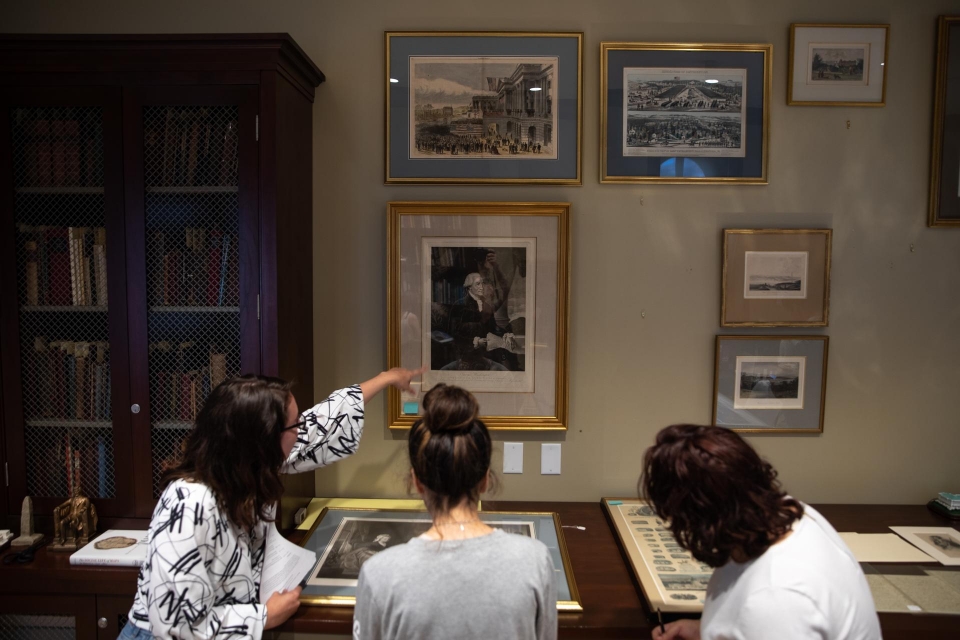Originally published on GWToday by Ruth Steinhardt
When Matthew West first saw the photograph of a small figure on the lawn of George Washington’s Mount Vernon estate, he thought it might be a child who had been enslaved. Slavery persisted at Mount Vernon until decades after Washington’s death, when the Mount Vernon Ladies’ Association took possession of the property in 1860.
“Mount Vernon was one of the first tourism sites, and the first interpreters in the mid-19th century were mostly freed slaves interpreting to a mostly white audience,” said Mr. West, a senior history and economics major at the George Washington University. “So plausibly this was someone who could have experienced that.”
The photograph was one of many objects that assistant curator Amber “Jackie” Streker pulled from the Albert H. Small Washingtoniana Collection at the beginning of last semester for a new challenge: Helping students in Denver Brunsman’s “George Washington and His World” class create a professional-grade exhibition at the George Washington University Museum and The Textile Museum.
Each student chose two objects from the collection of maps, photographs, artifacts, ephemera and other historical objects to research and write labels for. The exhibition opened at the museum this week and will remain open through July 26.
It’s a new way of engaging with the public history of the first American president from a class that has never limited its scope to the classroom. Students in “George Washington and His World” make multiple trips through the semester to Mount Vernon, the Virginia estate about 20 miles south of Washington, D.C., that Washington called home. With the help of experts and historians from Gelman Library, the Society of the Cincinnati, the Library of Congress and the Washington Library at Mount Vernon, students uncover a complex and intimate portrait of the man behind the mythical Founding Father.
For Dr. Brunsman, an associate professor of history in the Columbian College of Arts and Sciences, immersion in an era’s material culture can open a student to new levels of connection with their subject.
“I’ve learned from teaching this class that there’s something about objects that gives you a window into the world of the past,” Dr. Brunsman said. “Whether it’s a portrait that makes you think about how these people dressed and comported themselves, or an object they might have used in daily life, it’s a way for students to connect with a world that’s quite different than their own—through that common human experience.”
In previous iterations of the class, students chose artifacts from the Mount Vernon Museum to research and wrote items about them for Mount Vernon’s George Washington Digital Encyclopedia. Last semester’s students completed those entries.
But with the help of Mount Vernon experts, Ms. Streker and three graduate student assistants from GW’s history and museum studies programs, this semester’s students also created labels for the museum exhibit.
“This was a particularly intensive semester,” Dr. Brunsman admitted, laughing.
The labels were particularly challenging, Dr. Brunsman said, because while they can require many books’ worth of research, they have to be condensed into about 60 or 70 words. That often took many, many drafts
“These are public history works and clarity is essential,” Dr. Brunsman said. “Good enough is not good enough—a label needs to be publishable. I think that’s a valuable experience, whether students are working with a professional editor at the encyclopedia or with a professional curator at the museum.”
The exhibition is organized into three rooms: one for Mount Vernon itself, one for Washington, D.C., and one for the city of Alexandria, Va., which Washington called home. That organization required a lot of teamwork, Dr. Brunsman said.
“I try to communicate up front that, while everyone will be graded individually, this is a group effort, and it will only work if we all work together—and I think they really took that to heart,” Dr. Brunsman said. “I can see how doing something like this they might have felt slightly apprehensive at the beginning—I certainly did!—but they didn’t show me that. I just saw their effort and generous spirit.”
The research process also led to surprises. As Matthew West looked into the photograph he’d chosen to write about, he found that the records indicating it was from before the end of the Civil War were erroneous. In fact, the photograph probably originated from the 1870s, and the identity of the figure at its center remained a mystery.
“I thought that was cool, because you think it’s one thing—and the museum even buys it thinking that—but on further discovery you realize it might be something very different,” Mr. West said. “Maybe it’s just a picture of a child sitting on a lawn.”


